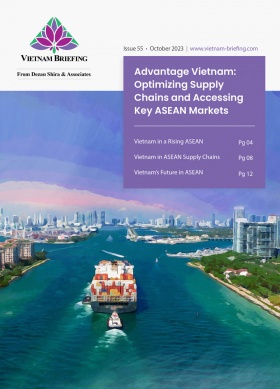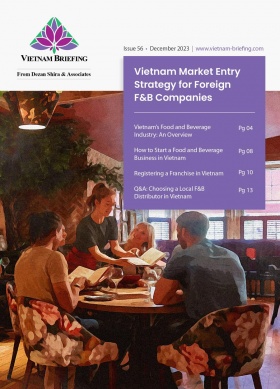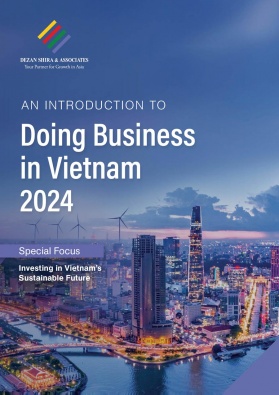Vietnam President To Lam’s State Visit to China: Key Highlights for Businesses
Vietnam’s Party General Secretary and President To Lam concluded his visit to China from August 18-20, resulting in the signing of 14 cooperation agreements and a joint statement with President Xi Jinping. We discuss how the visit further opens trade and investment opportunities between the two nations.
The economic objectives of To Lam’s visit to China
To Lam’s recent visit to China began in Guangzhou, the capital and largest city of Guangdong province, a key port city northwest of Hong Kong. A major focus of his agenda was to encourage investment from Guangdong’s businesses into Vietnam. Guangdong currently accounts for 20 percent of trade between China and Vietnam, driven by its dynamic business landscape.
Experts predict that economic ties between Guangdong and Vietnam will strengthen further due to the ongoing trend of production relocation, known as the “China plus one” strategy. A survey by the Vietnam Chamber of Commerce and Industry (VCCI) revealed that 59 percent of Chinese enterprises in Vietnam source their supplies from China—15 percentage points higher than other foreign firms.
In parallel, authorities of Guangxi province and the Vietnamese border provinces of Ha Giang, Quang Ninh, Lang Son, and Cao Bang have been working closely to facilitate trade activities. This has resulted in Quang Ninh’s electricity purchases from Guangxi’s power grid and the reopening of a border gate between Lang Son and Guangxi after COVID-19.
On Vietnam’s side, local leaders in Lao Cai, a mountainous province near the border with China, have advocated for developing a trade hub in the region. Particular attention has been given to Lao Cai’s recent proposal for a pilot cross-border e-commerce zone linking Vietnam and the Chinese market.
At the same time, Chinese firms are highly competitive in sectors prioritized by the Vietnamese government, such as renewable energy and electric vehicles (EVs).
Key highlights of Vietnam-China leaders’ joint statement
The joint statement between the top leaders of Vietnam and China reinforced the two countries’ commitment to collaboration across various domains, with a particular emphasis on economic and business ties.
China affirmed its support for Vietnam’s prosperous development and its efforts to build a strong, independent, and self-reliant economy. Additionally, China pledged to support Vietnam’s goals of renewal, industrialization, modernization, and comprehensive international integration. The Chinese government also reiterated that its friendship with Vietnam remains steadfast, and that Vietnam will continue to be a priority in China’s neighborhood diplomacy.
Strategic connectivity development
China and Vietnam have committed to enhancing strategic connectivity between the two countries, focusing on several key areas:
- Implementing the cooperation plan: Connecting Vietnam’s “Two Corridors, One Belt” Framework with China’s “Belt and Road” Initiative.
- Accelerating hard connectivity: Enhancing infrastructure such as railways, expressways, and border gate facilities.
- Upgrading soft connectivity: Improving smart customs systems.
- Chinese assistance: Supporting Vietnam in planning the Lang Son – Ha Noi and Mong Cai – Ha Long – Hai Phong standard gauge railway lines.
- Feasibility study: Developing a feasibility study report for the Lao Cai – Ha Noi – Hai Phong standard gauge railway line.
- Pilot construction: Speeding up the construction of smart border gates at the Huu Nghi (Vietnam) – Youyi Guan (China) international border gate and the dedicated cargo transport road in the area of boundary markers 1088/2 – 1089 (Tan Thanh – Po Chai).
- Cross-border economic zones: Actively researching and deploying pilot construction of cross-border economic cooperation zones.
- Supply chain collaboration: Jointly building safe and stable production and supply chains.
Enhancing business cooperation
The joint statement also underscores the importance of business collaboration, with both sides committing to promote two-way investments through various initiatives:
- Supporting key sectors: Encouraging enterprises in high-tech agriculture, infrastructure, clean energy, digital economy, and green development.
- Facilitating a favorable business environment: Ensuring a fair and supportive environment for each other’s enterprises.
- Exchanging expertise: Deepening the exchange of experiences in state-owned enterprise reform and management.
- Collaborating on human resources: Working together on training and development in human resources.
- Exploring mineral sector cooperation: Actively studying opportunities for greater cooperation in the key mineral sector.
- Utilizing financial cooperation mechanisms: Leveraging the financial and monetary cooperation working group between the two countries.
- Sharing policy management insights: Enhancing information exchange and experience sharing on policy management and reform in the financial-monetary field.
- Boosting monetary cooperation: Strengthening cooperation in monetary matters.
- Implementing economic and technical projects: Accelerating the implementation of projects like the Traditional Medicine Hospital (Subsidiary 2).
Upholding trade through bilateral and multilateral commitments
Both countries recognize the importance of promoting trade cooperation by:
- Effectively upholding the role of the Regional Comprehensive Economic Partnership (RCEP) and the ASEAN-China Free Trade Area (ACFTA).
- Making good use of e-commerce platforms and trade fairs.
- Enhancing customs cooperation and expanding the export of each country’s key products to the other.
- Accelerating the development of the ASEAN-China Free Trade Area 3.0.
- Stepping up the implementation of cooperation areas within the framework of Mekong-Lancang cooperation.
- Striving to promote the building of a Community with a Shared Future for Mekong-Lancang countries for peace and prosperity.
- Promoting cooperation within the Greater Mekong Sub-region (GMS) economic cooperation framework.
Concurrently, China is ready to continue creating favorable conditions for Vietnam to open additional trade promotion offices in various locations in China. Vietnam supports China’s accession to the Comprehensive and Progressive Agreement for Trans-Pacific Partnership (CPTPP) based on adherence to the agreement’s standards and procedures and actively welcomes the Hong Kong Special Administrative Region of China’s application to join the RCEP.
Vietnam, China ink 14 cooperation documents
On August 19, shortly after the talks between the two leaders, Vietnam and China signed 14 cooperation documents. These agreements underscore the commitment to strengthening the comprehensive strategic cooperative partnership between the two countries. The agreements are as follows:
- A Memorandum of Understanding (MOU) between the Ho Chi Minh National Academy of Politics (HCMA) and the National Academy of Governance
- An MOU on industrial cooperation between Vietnam’s Ministry of Industry and Trade (MOIT) and China’s Ministry of Industry and Information Technology
- An MOU on healthcare cooperation between the Ministry of Health (MOH) of Vietnam and the National Health Commission of China
- An MOU on enhancing cooperation and information exchange in banking operations between the State Bank of Vietnam and the People’s Bank of China
- An MOU between the Ministry of Planning and Investment and the China International Development Cooperation Agency (CIDCA) on promoting social and livelihood projects
- A protocol on plant quarantine for Vietnamese fresh coconut exported to China signed between Vietnam’s Ministry of Agriculture and Rural Development and the Chinese General Administration of Customs
- A protocol on health quarantine for crocodiles bred in Vietnam and exported to China between the Ministry of Agriculture and Rural Development and the General Administration of Customs
- A protocol on plant quarantine and food safety for frozen durian exported to China between the Ministry of Agriculture and Rural Development of Vietnam and the General Administration of Customs of China
- A certificate of handing over the results of the project to assist Vietnam in the planning of the Lao Cai – Hanoi – Haiphong standard gauge railways signed between the two governments
- An official letter between Vietnam’s Ministry of Transport and the CIDCA on the feasibility study of the technical aid project for planning two standard gauge railway lines: Lang Son – Hanoi and Mong Cai – Ha Long – Hanoi
- An agreement on cooperation between the Vietnam News Agency and Xinhua News Agency
- An MOU on strengthening cooperation between the Vietnam Television and the China Central Radio and Television
- An MOU on cooperation in traditional medicine between the Ministry of Health and the National Administration of Traditional Chinese Medicine
- An MOU on press and media exchange program 2024 2029 between the Vietnam Journalists’ Association and the All-China Journalists Association (ACJA)
In addition, two documents were announced at the signing ceremony, namely:
- An MOU on enhancing cooperation in the economic and trade fields between the Ministry of Industry and Trade of the Socialist Republic of Vietnam and the People’s Government of Hainan Province, People’s Republic of China; and
- An MOU on enhancing cooperation in the economic and trade fields between the Ministry of Industry and Trade of the Socialist Republic of Vietnam and the People’s Government of Shandong Province, People’s Republic of China.
Conclusion
To Lam’s decision to make China his first state visit emphasizes China’s importance in Vietnam’s strategic calculations, especially in supply chain and economic cooperation. The longstanding economic and business ties between the two nations are set to become even stronger, with enhanced connectivity and expanded trade cooperation promising new investment opportunities for businesses.
About Us
Vietnam Briefing is published by Asia Briefing, a subsidiary of Dezan Shira & Associates. We produce material for foreign investors throughout Asia, including ASEAN, China, and India. For editorial matters, contact us here and for a complimentary subscription to our products, please click here. For assistance with investments into Vietnam, please contact us at vietnam@dezshira.com or visit us at www.dezshira.com.
Dezan Shira & Associates assists foreign investors throughout Asia from offices across the world, including in Hanoi, Ho Chi Minh City, and Da Nang. We also maintain offices or have alliance partners assisting foreign investors in China, Hong Kong SAR, Dubai (UAE), Indonesia, Singapore, Philippines, Malaysia, Thailand, Bangladesh, Italy, Germany, the United States, and Australia.
- Previous Article How Will the 2024 US Presidential Election Outcome Shape US-Vietnam Relations?
- Next Article Vietnam’s Investment Surge in 2024: Key Trends































